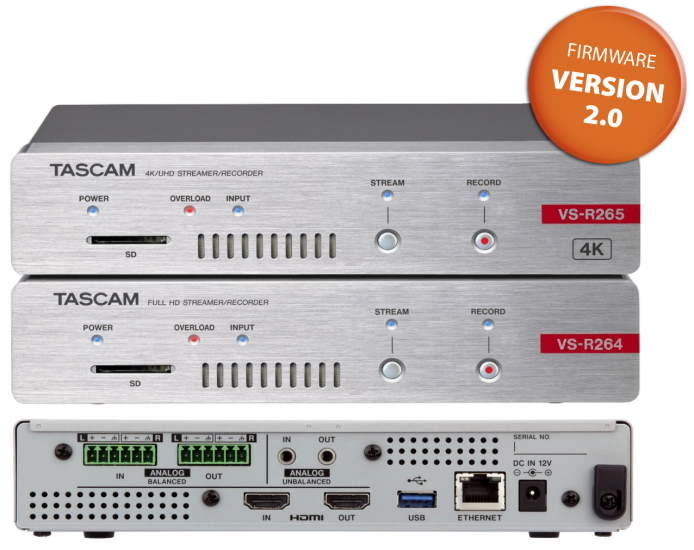New firmware version 2.0 for Tascam VS-R264/VS-R265 video streamers

Tascam announces the arrival of the version 2.0 update for their VS-R264/VS-R265 video-over-IP streamers/recorders. Hot on the heels of the recently published version 1.1.0 update that allows three simultaneous RTMP format streams, version 2.0 offers a wealth of new capabilities, including upgraded ability to record to internal storage, support for the MP4 recording file format, an expansion in the maximum size of files recorded to external storage, and more.
With version 2, users will appreciate that 17 GB of internal storage is now available for recording, with the maximum file size having been increased to 17 GB. For many applications, this increased capacity eliminates the need for external storage using an SD card or USB drive. Equally noteworthy, individual files recorded on an external storage may now be 4 GB instead of 2 GB in size. And the maximum file size can be limited to make recordings more manageable and to better address the user’s requirements. Under such conditions, a new recording is automatically started once the set file size limit is reached, and each file is stamped with date and time.
The update also provides support for continuous recording regardless of storage capacity: old files can be automatically deleted when storage reaches its maximum capacity. This new function ensures that there is always space available for new recordings, thus enabling longer, continuous recordings. This capability could be especially useful, for example, in situations where a church might record and stream one or two services each day. In this case, no ‘housekeeping’ of the storage media would be required. Further, as recorded files are completed, they can be automatically uploaded via FTP to a central FTP server while the recording of a new file continues — thus ensuring uninterrupted operation over long periods of time.
VS-R series users will also appreciate the fact that version 2.0 now supports the MP4 file format in addition to TS (Transport Stream). MP4 is a very popular audio/video streaming format, as it can also be used to store other data such as subtitles and still images. Now, users can choose between TS files, which are playable even if recording is interrupted by a power outage or some other unforeseen situation, or the more versatile MP4 format.
As part of the firmware update, several new options for the H.265 codec are available. H.265, also known as HEVC (High-Efficiency Video Coding), is a successor to H.264. It is the latest video compression standard, which is said to offer twice the data compression of H.264 with the same video quality. H.265 quality/latency can be set to High, Normal, Low or Lowest. Additionally, version 2.0 provides support for RTMP (Real-Time Messaging Protocol). RTMP 1/2/3 can now be controlled simultaneously by pressing the STREAM button. RTMP is a useful communications protocol intended to carry parallel streams of video, audio and data messages, with associated timing information, between a pair of communicating peers.
Users will also appreciate the updated streaming dashboard and web user interface, known as the Tascam Discovery application. Available for both Mac and Windows, Tascam Discovery enables multiple VS-R units connected to the network to be managed from a simple browser-based GUI. All configuration settings are saved within the VS-R devices, so that in normal operation, no computer is required for streaming or recording thereafter until settings need to be changed. The updated user interface provides better visibility of the status of each of the streaming outputs (up to eight simultaneous streams) and also of the recording function, in one view.
In addition to the primary enhancements made available as part of the version 2.0 update, numerous additional ‘fine-tunings’ have been implemented. These include improved video and audio streaming output using the RTSP protocol, improved AV sync performance, stabilised frame information for encoded video data, and improved colour space support for encoding. Previously, the disconnecting or connecting of LAN cables when using a static IP address would prevent the IP address from being determined. This has been corrected. Additionally, the adaptive bitrate streaming format HLS is now identified by its more common term HTTP Pull and the REST API has been updated to version 2.
The VS-R series version 2.0 update is slated to become available for download on 26 August.
 How to resolve AdBlock issue?
How to resolve AdBlock issue?